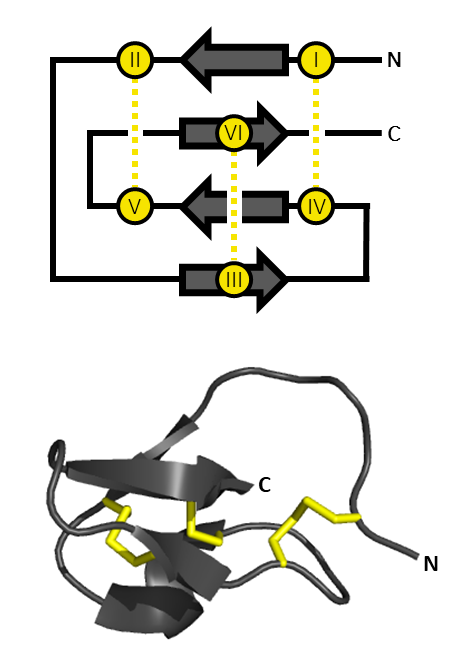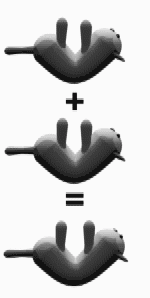|
Covalitoxin-II
Covalitoxin-II is a peptide toxin that is produced by the spider ''Coremiocnemis validus''. It can induce excitatory, non-lethal behavioral symptoms like quivering and jerking in crickets. Sources Covalitoxin-II (Cvtx-II) is a toxin in the venom of ''Coremiocnemis validus'' (Singapore or Blue femur tarantula).UniProt, UniProt Knowledge Base; P82601 (TXVL2_CORVA); published December 1, 2000; Last modified October 3, 2012; Date of retrieval October 16, 2012; This spider lives in South East Asian tropical forests. Chemistry Structure The toxin consists of 31 amino acids (ACSRAGENCYKSGRCCDGLYCKAYVVTCYKP). This sequence forms a peptide with a molecular weight of 3.4 kDa. It has six cysteine residues which form three disulphide bonds, between the specific amino acid locations 2&16, 19&21 and 15&28. There is an equal distribution of hydrophilic, hydrophobic and neutral amino acids. Near the C-terminus there is a positively charged surface formed by conserved basic residues, which is thou ... [...More Info...] [...Related Items...] OR: [Wikipedia] [Google] [Baidu] |
Inhibitor Cystine Knot
An inhibitor cystine knot (aka ICK or Knottin) is a protein structural motif containing three disulfide bridges. Knottins are one of three folds in the cystine knot motif; the other closely related knots are the Growth Factor Cystine Knot (GFCK) and the Cyclic Cystine Knot (CCK; cyclotide). Types include a) cyclic mobius, b) cyclic bracelet, c) acyclic inhibitor knottins. Cystine knot motifs are found frequently in nature in a plethora of plants, animals, and fungi and serve diverse functions from appetite suppression to anti-fungal activity. Along with the sections of polypeptide between them, two disulfides form a loop through which the third disulfide bond (linking the 3rd and 6th cysteine in the sequence) passes, forming a knot. The motif is common in invertebrate toxins such as those from arachnids and molluscs. The motif is also found in some inhibitor proteins found in plants, but the plant and animal motifs are thought to be a product of convergent evolution. The ICK moti ... [...More Info...] [...Related Items...] OR: [Wikipedia] [Google] [Baidu] |
Tarantula
Tarantulas comprise a group of large and often hairy spiders of the family Theraphosidae. , 1,040 species have been identified, with 156 genera. The term "tarantula" is usually used to describe members of the family Theraphosidae, although many other members of the same infraorder (Mygalomorphae) are commonly referred to as "tarantulas" or "false tarantulas". Some of the more common species have become popular in the exotic pet trade. Many New World species kept as pets have setae known as urticating hairs that can cause irritation to the skin, and in extreme cases, cause damage to the eyes. Overview Like all arthropods, the tarantula is an invertebrate that relies on an exoskeleton for muscular support.Pomeroy, R. (2014, February 4). Pub. Real Clear Science, "Spiders, and Their Amazing Hydraulic Legs and Genitalia". Retrieved October 13, 2019, from https://www.realclearscience.com/blog/2013/02/spiders-their-amazing-hydraulic-legs-and-genitals.html. Like other Arachnida, ... [...More Info...] [...Related Items...] OR: [Wikipedia] [Google] [Baidu] |
Conotoxins
A conotoxin is one of a group of Neurotoxicity, neurotoxic peptides isolated from the venom of the marine cone snail, genus ''Conus''. Conotoxins, which are peptides consisting of 10 to 30 amino acid residues, typically have one or more disulfide bonds. Conotoxins have a variety of mechanisms of actions, most of which have not been determined. However, it appears that many of these peptides modulate the activity of ion channels. Over the last few decades conotoxins have been the subject of pharmacological interest. The Median lethal dose, LD50 of conotoxin ranges from 5-25 μg/kg. Hypervariability Conotoxins are hypervariable even within the same species. They do not act within a body where they are produced (endogenously) but act on other organisms. Therefore, conotoxin genes experience less selection against mutations (like gene duplication and nonsynonymous substitution), and mutations remain in the genome longer, allowing more time for potentially beneficial novel fu ... [...More Info...] [...Related Items...] OR: [Wikipedia] [Google] [Baidu] |
Cone Snail
A cone is a three-dimensional geometric shape that tapers smoothly from a flat base (frequently, though not necessarily, circular) to a point called the apex or vertex. A cone is formed by a set of line segments, half-lines, or lines connecting a common point, the apex, to all of the points on a base that is in a plane that does not contain the apex. Depending on the author, the base may be restricted to be a circle, any one-dimensional quadratic form in the plane, any closed one-dimensional figure, or any of the above plus all the enclosed points. If the enclosed points are included in the base, the cone is a solid object; otherwise it is a two-dimensional object in three-dimensional space. In the case of a solid object, the boundary formed by these lines or partial lines is called the ''lateral surface''; if the lateral surface is unbounded, it is a conical surface. In the case of line segments, the cone does not extend beyond the base, while in the case of half-line ... [...More Info...] [...Related Items...] OR: [Wikipedia] [Google] [Baidu] |
Conotoxin
A conotoxin is one of a group of neurotoxic peptides isolated from the venom of the marine cone snail, genus ''Conus''. Conotoxins, which are peptides consisting of 10 to 30 amino acid residues, typically have one or more disulfide bonds. Conotoxins have a variety of mechanisms of actions, most of which have not been determined. However, it appears that many of these peptides modulate the activity of ion channels. Over the last few decades conotoxins have been the subject of pharmacological interest. The LD50 of conotoxin ranges from 5-25 μg/kg. Hypervariability Conotoxins are hypervariable even within the same species. They do not act within a body where they are produced (endogenously) but act on other organisms. Therefore, conotoxin genes experience less selection against mutations (like gene duplication and nonsynonymous substitution), and mutations remain in the genome longer, allowing more time for potentially beneficial novel functions to arise. Variability in c ... [...More Info...] [...Related Items...] OR: [Wikipedia] [Google] [Baidu] |
Righting Reflex
The righting reflex, also known as the labyrinthine righting reflex, is a reflex that corrects the orientation of the body when it is taken out of its normal upright position. It is initiated by the vestibular system, which detects that the body is not erect and causes the head to move back into position as the rest of the body follows. The perception of head movement involves the body sensing linear acceleration or the force of gravity through the otoliths, and angular acceleration through the semicircular canals. The reflex uses a combination of visual system inputs, vestibular inputs, and somatosensory inputs to make postural adjustments when the body becomes displaced from its normal vertical position. These inputs are used to create what is called an efference copy. This means that the brain makes comparisons in the cerebellum between expected posture and perceived posture, and corrects for the difference. The reflex takes 6 or 7 weeks to perfect, but can be affected by various t ... [...More Info...] [...Related Items...] OR: [Wikipedia] [Google] [Baidu] |
ID50
The concept of minimal infective dose (MID) has traditionally been used for infectious bacteria that contaminate foods. MID was defined as the number of bacteria ingested (the dose) from which a pathology is observed in the consumer. Examples such as this are found in textbooks: to cause gastrointestinal disorders, the food must contain more than 100,000 ''Salmonella'' per gram. However, in such a formulation, an inaccuracy immediately becomes apparent: to know the dose ingested, concentration is not enough. It is also necessary to know the mass of the portion: :d\ =\ c \times m where: *d = number of bacteria i.e. dose *c = concentration of bacteria *m = mass Nevertheless, this formulation has served as a basis for reasoning to establish the maximum concentrations permitted by the microbiological regulatory criteria intended to protect the health of consumers. Thus in 1992, as the outbreaks previously caused by ''Listeria'' ''monocytogenes'' involved only food containing more th ... [...More Info...] [...Related Items...] OR: [Wikipedia] [Google] [Baidu] |



